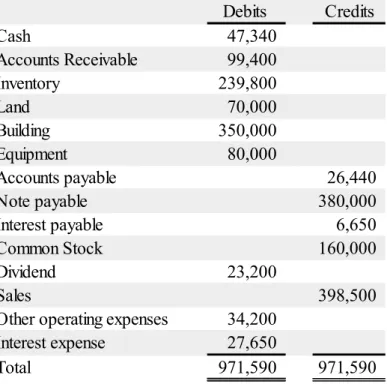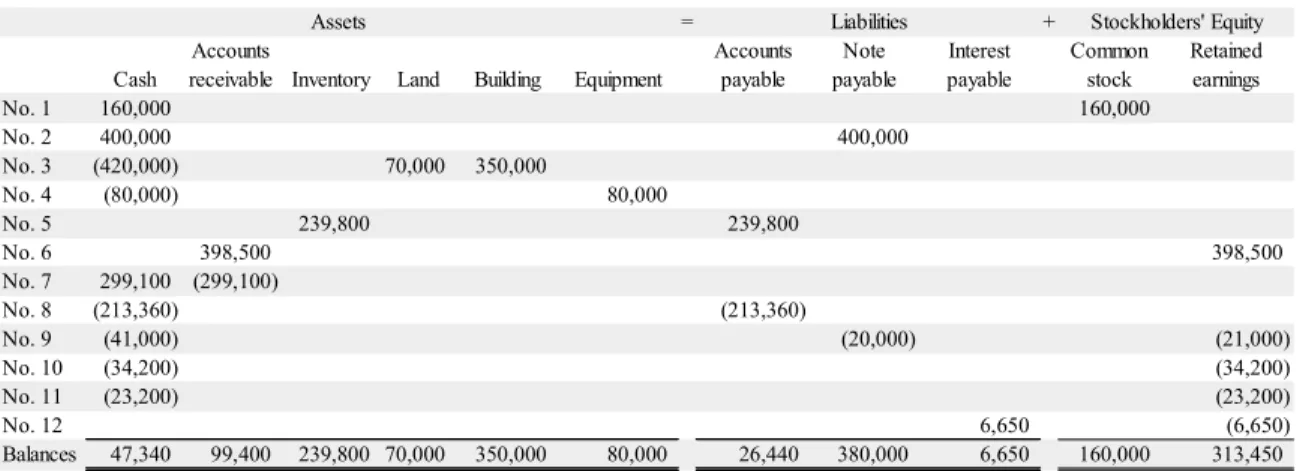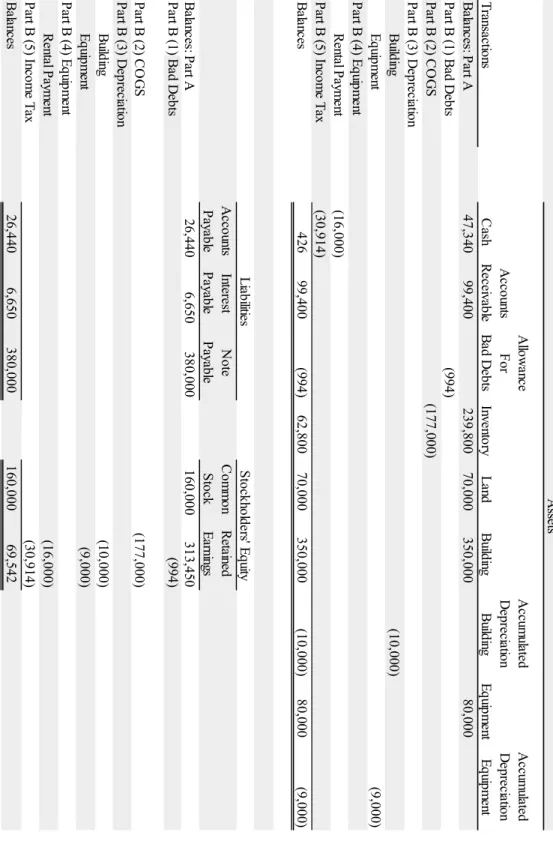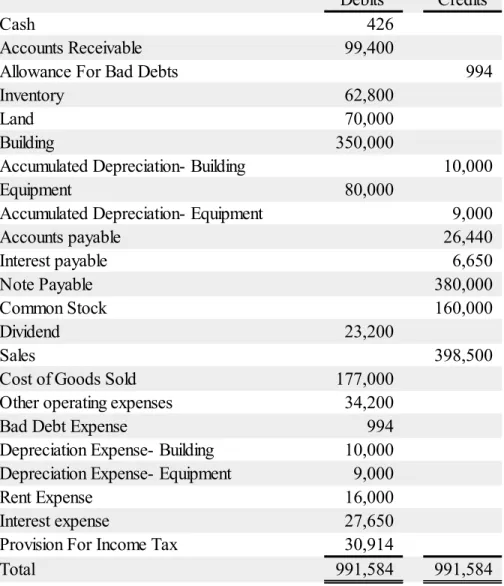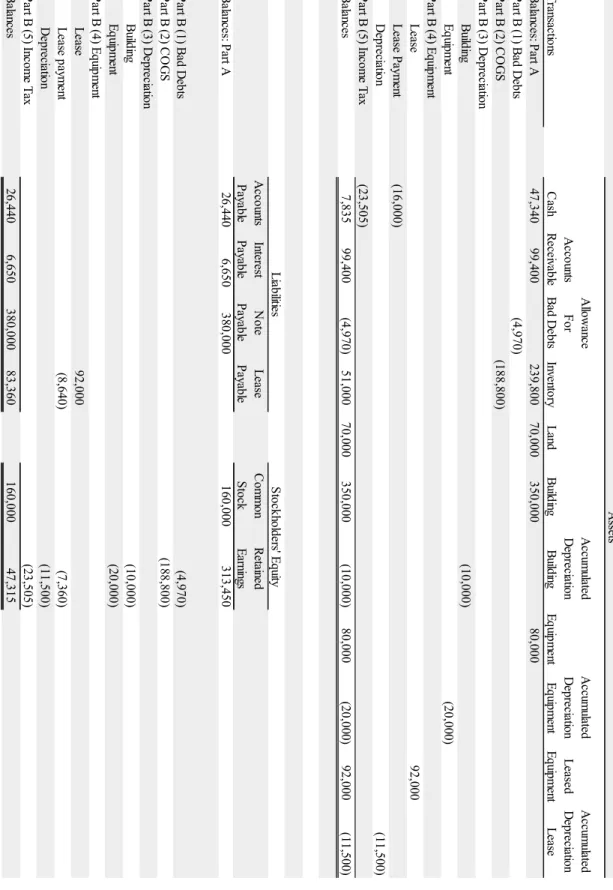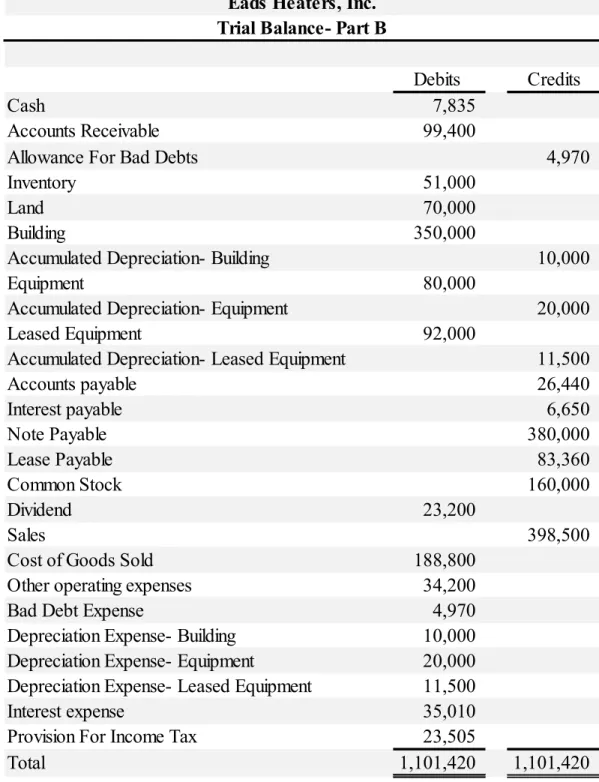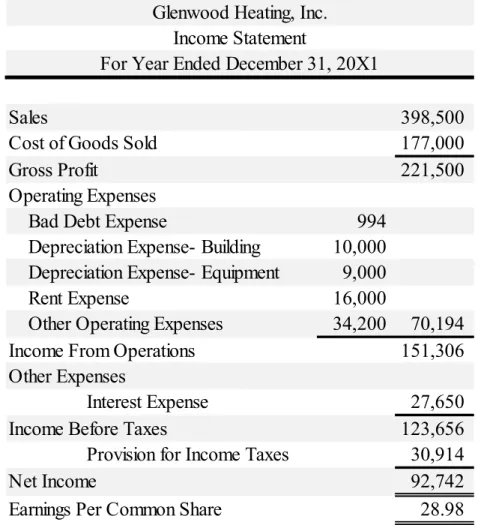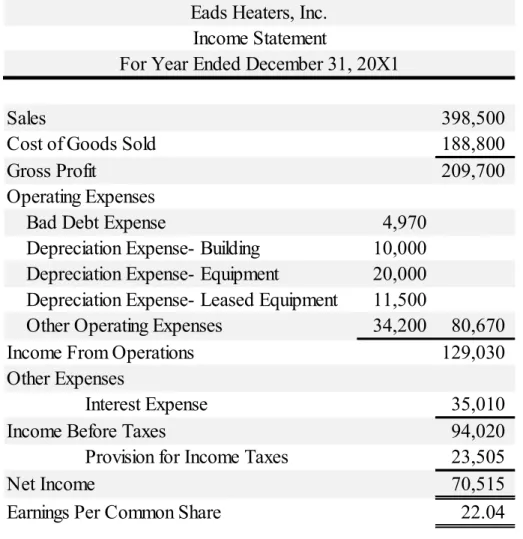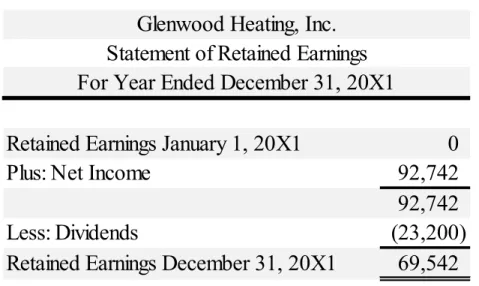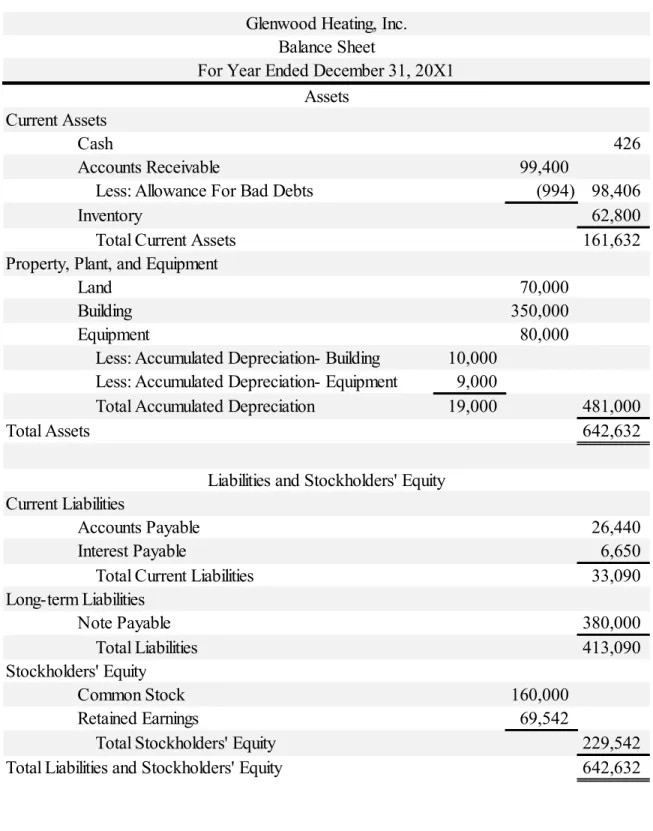Case Analyses of Accounting Concepts and Methodologies By Austin Newton Garrett
A thesis submitted to the faculty of the University of Mississippi in partial fulfillment of the requirements of the Sally McDonnell Barksdale Honors College.
Oxford May 2018
Approved By
Advisor: Dr. Victoria Dickinson
Reader: Dr. Mark Wilder
ABSTRACT
AUSTIN GARRETT: Case Analyses of Accounting Concepts and Methodologies (Under the direction of Victoria Dickinson)
As accounting majors in the Sally Barksdale Honors College at Ole Miss, students are offered an honors accounting course that involves weekly class meetings that allow them to satisfy the thesis requirement of the Honors College. Rather than attempting to write a traditional thesis while reporting to the dean during the spring internship, the Honors 420 Alternative Thesis Course allows students to complete twelve different case studies that are ultimately compiled into a final thesis. Each case is completed by using different methods of research and compilation. Research includes analyzing publications in the FASB codification, examining financial statements in cases presented in class, and also searching through the intermediate textbook to discover new ideas and concepts not specifically covered in class. The cases are then compiled using Word and Excel, each requiring a fundamental knowledge of the Microsoft tools. No case uses the exact same incorporations of the methodologies, and thus, a new challenge is presented with each case.
Because of the new challenges presented each week, students in the class have an opportunity to develop a deeper knowledge of fundamental concepts in the accounting profession than with a traditional thesis track.
TABLE OF CONTENTS
Introduction ...1
Case Study One ...5
Case Study Two ...20
Case Study Three ...24
Case Study Four ...30
Case Study Five ...33
Case Study Six ...38
Case Study Seven ...42
Case Study Eight ...46
Case Study Nine ...51
Case Study Ten ...56
Case Study Eleven ...61
Case Study Twelve ...66
INTRODUCTION
Summary of Findings: Overall, the class helps students develop an enhanced knowledge of financial reporting, technical skills, theoretical concepts, and research, all equally important in the field of Accounting. Early in the year, the class was introduced to the development of financial statements in Excel. Though a tedious task, the introduction into Excel is important for understanding the way each financial statement relates to the other, due to the ability to link cells and formulas within each document. Once financial statements are crafted, students are then asked to analyze specific values through the use of ratios and yearly comparisons. Though understanding the compilation of the financials is important, the analysis of the statements is the key to comprehending what is occurring from year to year within an organization.
Since many of the topics have not been taught in intermediate at the time they are presented in class, the analysis is challenging at times. Therefore, each case is discussed in teams of three to four in order to alleviate some of the confusion. Throughout school, students are presented with opportunities to work in small groups with their peers on projects, presentations, and other assignments. Unfortunately, the group work assigned in many classes often leads to one student hating group work, as he or she is forced to do the majority of the work. The Honors 420 coursework is different because every student in the class is equally prepared and eager to learn new concepts, and each student offers different interpretations on the new topics. Because individual reports are made by each person, the interpretations differ in every thesis. The experience of working with a high performing team in class directly correlates to the workplace. In most financial organizations, the ability of employees to work collaboratively in teams is prevalent to the success of the
company. Whenever an accounting firm presents to the class, whether a member of the big four or smaller firm, the ability to work in teams is an overarching theme. The experience of discussing and analyzing accounting concepts in teams is one of the most important skills honed during the course. The exposure to more technical team building is a unique opportunity that is not offered with a more traditional thesis.
Though one or two individuals in a group may have a deeper understanding of a particular topic, each group member must develop an in depth comprehension of the content in order to write his or her own analysis. Therefore, an enhanced knowledge of theoretical accounting concepts is developed. Individuals must understand how to calculate certain figures, such as depreciation, income tax expense, and ratios. However, equations can easily be found through research, so the challenge presented in many of the cases is the analysis of the figures. In order to craft a complete report, an understanding of where the calculations come from is necessary. The comprehension of the concepts is developed through a thorough reading of each case, presentations Dr. Dickinson, and oftentimes research. Prior to learning the material in intermediate accounting, each case offered an opportunity to develop an understanding of concepts many students find challenging. For example, case nine presents the idea of stock options and warrants. Within the written case are descriptions of the company’s stock option plans that are confusing for a student who has no prior experience with the material. Therefore, the case allows students to search for definitions in the intermediate textbook. Many of the definitions are not found in the text, so Google is the next best option. As all the terms are found, the stock option plans become
defining of key definitions and ideas, the process includes journal entries and calculations, followed by a final analysis. The defining of terms helps individuals better understand how to create journal entries for the topic. The journal entries help connect the terms with real world applications, and thus, the real world applications create a deeper understanding that allows for the crafting of a final analysis. Much like case nine, many of the cases include a straightforward process that assists in instituting a complete understanding of important theoretical accounting concepts.
The complete understanding of the concepts is not possible without in-depth research. Whether through the use of the FASB codification, Google, or the intermediate textbook, the research is imperative to the completion of the thesis. Similar to group work, research is a predominant aspect of the learning environment at all educational levels.
However, the course offers an opportunity to participate in researching that is applicable to the accounting profession that has not been offered in the past. Understanding how to navigate the FASB codification, for example, is a skill that is difficult to possess without the knowledge of how the system is formatted. The skill of researching difficult ideologies and applying the findings to each case is experience that is invaluable in the development of a successful career.
Career Development: The accounting profession offers many opportunities, whether in the field itself or in other areas of business. Though companies generate a high demand for accountants, starting and continuing a successful career presents challenges due to the competitive nature of the career path. As many college students have experienced, the recruitment process for spring internships truly begins Fall of junior year. Students quickly
realize that a strong resume is critical to securing interviews that will hopefully lead to the internship opportunity. However, once an internship is secured, the resume is essentially thrown away and strong performance during the internship is the standard. Though new interns are not introduced into very high level material, the skills acquired in college contribute to performance.
The skills learned in the Honors 420 class help set students apart early in the internship. The ability to work in teams, conduct research, and understand new ideas are all critical to high performance during the internship that are hard skills to develop in a traditional classroom setting. Not only will these skills help one perform well during an internship, but they will also remain prevalent throughout one’s career. Researching will always be a necessary skill for accountants as FASB continues to change fundamental accounting concepts affecting how transactions are accounted for in financials. Working in teams will never become outdated as each level of an organization is centered around individuals collaborating and working towards a common goal. Finally, an ability to learn new concepts and ideas will always remain prevalent as strategies and goals change within an organization. All are skills improved upon in the Honors 420 class and are vitally important to a successful career in the field of accounting.
CASE STUDY ONE Home Heaters: Glenwood vs. Eads
Financial Reporting
Introduction: The following case study compares the financial documents and accounting decisions of two heating companies conducting operations in Colorado: Glenwood Heating and Eads Heaters. Part A involves the first year transactions of each company, while Part B demonstrates differing year-end decisions made by each manager. Also included are the Income Statement, the Statement of Retained Earnings, the Balance Sheet, and the Statement of Cash Flows of each company which have been used to generate ratios necessary to determining the best investment. Upon further examination of the following documents and computations, the decision has been made that Glenwood Heating is the better investment.
Part A:
Table 1-1 Basic Transactions
Table 1-2 Basic Trial Balance
= +
Cash
Accounts
receivable Inventory Land Building Equipment
Accounts payable
Note payable
Interest payable
Common stock
Retained earnings
No. 1 160,000 160,000
No. 2 400,000 400,000
No. 3 (420,000) 70,000 350,000
No. 4 (80,000) 80,000
No. 5 239,800 239,800
No. 6 398,500 398,500
No. 7 299,100 (299,100)
No. 8 (213,360) (213,360)
No. 9 (41,000) (20,000) (21,000)
No. 10 (34,200) (34,200)
No. 11 (23,200) (23,200)
No. 12 6,650 (6,650)
Balances 47,340 99,400 239,800 70,000 350,000 80,000 26,440 380,000 6,650 160,000 313,450
Assets Liabilities Stockholders' Equity
Debits Credits
Cash 47,340
Accounts Receivable 99,400
Inventory 239,800
Land 70,000
Building 350,000
Equipment 80,000
Accounts payable 26,440
Note payable 380,000
Interest payable 6,650
Common Stock 160,000
Dividend 23,200
Sales 398,500
Other operating expenses 34,200
Interest expense 27,650
Total 971,590 971,590
Part B:
Table 1-3 Glenwood Additional Information
Cash AccountsReceivable AllowanceFor Bad DebtsInventoryLandBuilding Accumulated Depreciation BuildingEquipment AccumDepreciaEquipBalances: Part A47,34099,400239,80070,000350,00080,000Part B (1) Bad Debts(994)Part B (2) COGS(177,000)Part B (3) Depreciation Building(10,000) Equipment(9Part B (4) Equipment Rental Payment(16,000)Part B (5) Income Tax(30,914)Balances42699,400(994)62,80070,000350,000(10,000)80,000(9 AccountsPayable Interest Payable NotePayable CommonStock Retained EarningsBalances: Part A26,4406,650380,000160,000313,450Part B (1) Bad Debts(994)
Part B (2) COGS(177,000)Part B (3) Depreciation Building(10,000) Equipment(9,000)Part B (4) Equipment Rental Payment(16,000)Part B (5) Income Tax(30,914)Balances26,4406,650380,000160,00069,542 Assets
Transactions
LiabilitiesStockholders' Equity
Table 1-4 Glenwood Trial Balance
Debits Credits
Cash 426
Accounts Receivable 99,400
Allowance For Bad Debts 994
Inventory 62,800
Land 70,000
Building 350,000
Accumulated Depreciation- Building 10,000
Equipment 80,000
Accumulated Depreciation- Equipment 9,000
Accounts payable 26,440
Interest payable 6,650
Note Payable 380,000
Common Stock 160,000
Dividend 23,200
Sales 398,500
Cost of Goods Sold 177,000
Other operating expenses 34,200
Bad Debt Expense 994
Depreciation Expense- Building 10,000 Depreciation Expense- Equipment 9,000
Rent Expense 16,000
Interest expense 27,650
Provision For Income Tax 30,914
Total 991,584 991,584
Table 1-5 Eads Additional Information
Cash AccountsReceivable AllowanceFor Bad DebtsInventoryLandBuilding AccumulatedDepreciation BuildingEquipment AccumulatedDepreciation Equipment LeasedEquipment AccDep
Balances: Part A47,34099,400239,80070,000350,00080,000Part B (1) Bad Debts(4,970)Part B (2) COGS(188,800)Part B (3) Depreciation Building(10,000) Equipment(20,000)Part B (4) Equipment Lease92,000 Lease Payment(16,000) DepreciationPart B (5) Income Tax(23,505)Balances7,83599,400(4,970)51,00070,000350,000(10,000)80,000(20,000)92,000
AccountsPayable Interest Payable NotePayable Lease Payable CommonStock Retained EarningsBalances: Part A26,4406,650380,000160,000313,450
Part B (1) Bad Debts(4,970)Part B (2) COGS(188,800)Part B (3) Depreciation Building(10,000) Equipment(20,000)Part B (4) Equipment Lease92,000 Lease payment(8,640)(7,360) Depreciation(11,500)Part B (5) Income Tax(23,505)Balances26,4406,650380,00083,360160,00047,315 Transactions Assets
LiabilitiesStockholders' Equity
Table 1-6 Eads Trial Balance
Debits Credits
Cash 7,835
Accounts Receivable 99,400
Allowance For Bad Debts 4,970
Inventory 51,000
Land 70,000
Building 350,000
Accumulated Depreciation- Building 10,000
Equipment 80,000
Accumulated Depreciation- Equipment 20,000
Leased Equipment 92,000
Accumulated Depreciation- Leased Equipment 11,500
Accounts payable 26,440
Interest payable 6,650
Note Payable 380,000
Lease Payable 83,360
Common Stock 160,000
Dividend 23,200
Sales 398,500
Cost of Goods Sold 188,800
Other operating expenses 34,200
Bad Debt Expense 4,970
Depreciation Expense- Building 10,000 Depreciation Expense- Equipment 20,000 Depreciation Expense- Leased Equipment 11,500
Interest expense 35,010
Provision For Income Tax 23,505
Total 1,101,420 1,101,420
Eads Heaters, Inc.
Trial Balance- Part B
Table 1-7 Glenwood Income Statement
Sales 398,500
Cost of Goods Sold 177,000
Gross Profit 221,500
Operating Expenses
Bad Debt Expense 994
Depreciation Expense- Building 10,000 Depreciation Expense- Equipment 9,000
Rent Expense 16,000
Other Operating Expenses 34,200 70,194
Income From Operations 151,306
Other Expenses
Interest Expense 27,650
Income Before Taxes 123,656
Provision for Income Taxes 30,914
Net Income 92,742
Earnings Per Common Share 28.98
Glenwood Heating, Inc.
Income Statement
For Year Ended December 31, 20X1
Table 1-8 Eads Income Statement
Sales 398,500
Cost of Goods Sold 188,800
Gross Profit 209,700
Operating Expenses
Bad Debt Expense 4,970
Depreciation Expense- Building 10,000 Depreciation Expense- Equipment 20,000 Depreciation Expense- Leased Equipment 11,500
Other Operating Expenses 34,200 80,670
Income From Operations 129,030
Other Expenses
Interest Expense 35,010
Income Before Taxes 94,020
Provision for Income Taxes 23,505
Net Income 70,515
Earnings Per Common Share 22.04
Eads Heaters, Inc.
Income Statement
For Year Ended December 31, 20X1
Table 1-9 Glenwood Retained Earnings
Table 1-10 Eads Retained Earnings
Retained Earnings January 1, 20X1 0
Plus: Net Income 92,742
92,742
Less: Dividends (23,200)
Retained Earnings December 31, 20X1 69,542 For Year Ended December 31, 20X1
Statement of Retained Earnings Glenwood Heating, Inc.
Retained Earnings January 1, 20X1 0
Plus: Net Income 70,515
70,515
Less: Dividends (23,200)
Retained Earnings December 31, 20X1 47,315 Eads Heaters, Inc.
Statement of Retained Earnings
For Year Ended December 31, 20X1
Table 1-11 Glenwood Balance Sheet
Current Assets
Cash 426
Accounts Receivable 99,400
Less: Allowance For Bad Debts (994) 98,406
Inventory 62,800
Total Current Assets 161,632
Property, Plant, and Equipment
Land 70,000
Building 350,000
Equipment 80,000
Less: Accumulated Depreciation- Building 10,000 Less: Accumulated Depreciation- Equipment 9,000
Total Accumulated Depreciation 19,000 481,000
Total Assets 642,632
Current Liabilities
Accounts Payable 26,440
Interest Payable 6,650
Total Current Liabilities 33,090
Long-term Liabilities
Note Payable 380,000
Total Liabilities 413,090
Stockholders' Equity
Common Stock 160,000
Retained Earnings 69,542
Total Stockholders' Equity 229,542
Total Liabilities and Stockholders' Equity 642,632
Liabilities and Stockholders' Equity Glenwood Heating, Inc.
Balance Sheet
For Year Ended December 31, 20X1 Assets
Table 1-12 Eads Balance Sheet
Current Assets
Cash 7,835
Accounts Receivable 99,400
Less: Allowance For Bad Debts 4,970 94,430
Inventory 51,000
Total Current Assets 153,265
Property, Plant, and Equipment
Land 70,000
Building 350,000
Equipment 80,000
Leased Equipment 92,000
Less: Accumulated Depreciation- Building 10,000 Less: Accumulated Depreciation- Equipment 20,000 Less: Accumulated Depreciation- Leased Equipment 11,500 Total Accumulated Depreciation 41,500
Total Plant, Property, and Equipment 550,500
Total Assets 703,765
Current Liabilities
Accounts Payable 26,440
Interest Payable 6,650
Total Current Liabilities 33,090
Long-term Liabilities
Note Payable 380,000
Lease Payable 83,360
Total Liabilities 496,450
Stockholders' Equity
Common Stock 160,000
Retained Earnings 47,315
Total Stockholders' Equity 207,315
Total Liabilities and Stockholders' Equity 703,765
Eads Heaters, Inc.
Balance Sheet
For Year Ended December 31, 20X1 Assets
Liabilities and Stockholders' Equity
Table 1-13 Glenwood Cash Flows
Cash Flows From Operating Activities
Net Income 92,742
Adjustments
Depreciation Expense- Building 10,000 Depreciation Expense- Equipment 9,000 Changes in Current Assets and Liabilities
Increase in Accounts Receivable (99,400) Increase in Allowance for Bad Debts 994 Increase in Inventory (62,800) Increase in Accounts Payable 26,440
Increase in Interest Payable 6,650 (109,116) Total Cash Flows From Operating Activities (16,374) Cash Flows From Investing Activities
Purchase of Land (70,000)
Purchase of Building (350,000)
Purchase of Equipment (80,000)
Total Cash Flows From Investing Activities (500,000) Cash Flows From Financing Activities
Received Cash for Common Stock 160,000 Received Cash for Note Payable 380,000
Paid Cash Dividends (23,200)
Total Cash Flows From Financing Activities 516,800
Current Year Cash Flows 426
Glenwood Heating, Inc.
Statement of Cash Flows For Year Ended December 31, 20X1
Table 1-14 Eads Cash Flows
Cash Flows From Operating Activities
Net Income 70,515
Adjustments
Depreciation Expense- Building 10,000 Depreciation Expense- Equipment 20,000 Depreciation Expense- Leased Equipment 11,500 Changes in Current Assets and Liabilities
Increase in Accounts Receivable (99,400) Increase in Allowance for Bad Debts 4,970
Increase in Inventory (51,000)
Increase in Accounts Payable 26,440
Increase in Interest Payable 6,650 (70,840) Total Cash Flows From Operating Activities (325) Cash Flows From Investing Activities
Purchase of Land (70,000)
Purchase of Building (350,000)
Purchase of Equipment (80,000)
Total Cash Flows From Investing Activities (500,000) Cash Flows From Financing Activities
Received Cash for Common Stock 160,000
Received Cash for Note Payable 380,000
Payment of Lease (8,640)
Paid Cash Dividends (23,200)
Total Cash Flows From Financing Activities 508,160
Current Year Cash Flows 7,835
Eads Heaters, Inc.
Statement of Cash Flows For Year Ended December 31, 20X1
Table 1-15 Glenwood vs. Eads
Final Analysis:
In order to determine which company is the best investment, one must analyze the ratios derived from the financial statements. As seen by the current ratio, Glenwood is better prepared to fulfill short-term and long-term obligations, but Eads’s lower acid-test ratio demonstrates the company’s ability to pay off current liabilities with its liquid assets.
However, Eads has a larger debt ratio thus demonstrating that the company is financing more of its assets with debt than Glenwood. Therefore, the two companies seem to be equally equipped to handle paying off debt, but Glenwood seems to have a slight advantage in terms of debt financing. In regards to profitability, Glenwood has the advantage as demonstrated by the larger gross profit margin, return on assets, and return on equity. Due to its greater profitability, Glenwood’s earnings per share remains 31 percent higher than Eads. Overall, Glenwood is the better investment due to its profitability advantage over Eads.
Glenwood Eads
Current Ratio 4.88 4.63
Acid-Test Ratio 3.02 3.24
Gross Profit Margin 0.56 0.53
Return on Assets 0.14 0.1
Return on Equity 0.4 0.34
Earnings per Share 28.98 22.04
Debt Ratio 0.64 0.71
CASE STUDY TWO Totz Co.
Sales and Related Transactions
Introduction: In Case Study Two, the FASB codification is used as a researching tool to determine how to account for transactions involving the company “Totz.” The transactions involve sales, cost of sales, unusual events, and also activity regarding the services of Doodlez, a separate division of Totz.
1. Totz generated $74.5 million in net sales during fiscal 2015 and $86.5 million in net sales during fiscal 2016. Much of the increase derived from service revenues provided by Doodlez. According to Regulation S-X, Rule 5-03, Income Statements, Totz must
“state separately: (a) Net sales of tangible products (gross sales less discounts, returns and allowances), (b) operating revenues of public utilities or others; (c) income from rentals; (d) revenues from services; and (e) other revenues.” Regulation S-X, Rule 5- 03 (b) goes on to state that “each class which is not more than 10 percent of the sum of the items may be combined with another class” (ASC-225-10-S99-2). However, service revenue attributable to Doodlez is greater than ten percent. Therefore, Totz must state its revenue from sales of children’s clothing and revenue generated from services offered by Doodlez as separate line items on the face of the income statement for all periods presented.
2. After recording net sales on the income statement, Totz now must decide how it will record cost of sales, which includes direct labor costs for Doodlez employees. Similar to its statement of net sales, Totz must “state separately the amount of: (a) cost of tangible goods sold, (b) operating expenses of public utilities or others, (c) expenses applicable to rental income, (d) cost of services, and (e) expenses applicable to other
revenues” (ASC-225-10-S99-8). The guidance also states that in order “to avoid placing undue emphasis on ‘cash flow,’ depreciation, depletion, and amortization should not be positioned in the income statement in a manner which results in reporting a figure for income before depreciation” (ASC-225-10-S99-8). Therefore, Totz should not report a gross profit subtotal and must record its expenses incurred when acquiring and producing inventory for sale separately from the direct labor costs for Doodlez employees.
3. Totz experienced a $1.7 million gain on the sale of its old headquarters. ASC-605-10- S99-1 states that “gains or losses from the sale of assets should be reported as ‘other general expenses’… Any material item should be stated separately.” The codification also states that “a gain or loss recognized on the sale of the long-lived asset (disposal group) that is not a component of an entity shall be included in income from continuing operations before income taxes in the income statement of a business entity” (ASC- 360-10-45-5). Additionally, the event is “usual in nature” and is also considered “a consequence of customary and continuing business activities” (ASU-225-45-4).
Therefore, in accordance with all the above guidance, the gain will be reported on the income statement before income taxes as operating income.
4. Totz settled a class action lawsuit upon realizing that its fabric suppliers were not
event’s unusual nature, Totz must record the $2.7 million in proceeds on the income statement “as a separate component of income from continuing operations within operating income or, alternatively,” disclose the event “in notes to financial statements”
(ASU-225-45-16).
CASE STUDY THREE XXXXX
Basic Accounting Transactions
Introduction: The following case involves accounting for several transactions and how these transactions affect the trial balance of a company. The case includes entries formatted untraditionally in an excel table, both an unadjusted and post-closing trial balance, and a labeling of the entries based on the affect they have on the statement of cash flows. Also included are an updated income statement and balance sheet for the company.
Table 3-1 Entries and Unadjusted Trial Balance:
Cash Flows Key:OperatingInvestingFinancing
Beginning balance (February 28,2009)
1. Purchase inventory
2. Incur factory wages
3. Sell inventory for cash and on account
4. Pay for inventory
5. Collect receivables
6. Incur SG&A (cash and payable)
7. Pay wages
8. Receive franchise fee
9. Purchase PPE
10. Dividends declared and paid
11. All other
Cash and cash equivalents1,253,947 17,000,000(8,200,000)4,100,000(2,000,000)(6,423,789)125,000(498,832)(2,403,458)79Accounts receivable4,229,733 5,000,000(4,100,000)(702Notes receivable, current- 91Inventories4,064,611 7,500,0006,000,000(14,000,000)(6Deferred income taxes369,197 92Other224,378 (4Property and equipment, net5,253,598 498,83213Notes receivable, less current portion124,452 13Goodwill, net1,046,944 Intangible assets, net183,135 (7Other91,057 (3Accounts payable 1,074,643 7,500,000(8,200,000)50Accrued salaries and wages423,789 6,000,000(6,423,789)Other accrued expenses531,941 3,300,000(2,885Dividend payable598,986 3,709Deferred income 142,000 125,000(4Deferred income taxes827,700 66Common stock179,696 Additional paid-in capital7,311,280 31Retained earnings5,751,017 (2,407,167)Sales- 22,000,00094Franchise and royalty fees- 5,492Cost of sales- 14,000,00069Franchise costs- 1,499Sales and marketing- 1,505,431General and administrative- 2,044,569(261Retail operating- 1,750,000Depreciation and amortization- Interest income- (2Income tax expense- 2,090A=L+OE+R-E- - - - - - - - - - -
Table 3-2 Entries and Post-Closing Trial Balance:
Cash Flows Key:OperatingInvestingFinancing
Unadjusted trial balance
12. Adjust for inventory count
13. Record depreciation 14.Wages accrual
15. Consultant's report (no entry)
Pre-closing trial balance
16. Closing entries
Post-closing (ending) balance
Actual February 28, 2010 F/S figures Cash and cash equivalents3,743,0923,743,0923,743,0923,743,092Accounts receivable4,427,5264,427,5264,427,5264,427,526Notes receivable, current91,05991,05991,05991,059Inventories3,498,283(216,836)3,281,4473,281,4473,281,447Deferred income taxes461,249461,249461,249461,249Other220,163220,163220,163220,163Property and equipment, net5,885,289(698,580)5,186,7095,186,7095,186,709Notes receivable, less current portion263,650263,650263,650263,650Goodwill, net1,046,9441,046,9441,046,9441,046,944Intangible assets, net110,025110,025110,025110,025Other88,05088,05088,05088,050Accounts payable 877,832877,832877,832877,832Accrued salaries and wages- 646,156646,156646,156646,156Other accrued expenses946,528946,528946,528946,528Dividend payable602,694602,694602,694602,694Deferred income 220,938220,938220,938220,938Deferred income taxes894,429894,429894,429894,429Common stock180,808180,808180,808180,808Additional paid-in capital7,626,6027,626,6027,626,6027,626,602Retained earnings3,343,8503,343,8503,580,0776,923,9276,923,927Sales22,944,01722,944,017(22,944,017)- 22,944,017Franchise and royalty fees5,492,5315,492,531(5,492,531)- 5,492,531Cost of sales14,693,786216,83614,910,622(14,910,622)- 14,910,622Franchise costs1,499,4771,499,477(1,499,477)- 1,499,477Sales and marketing1,505,4311,505,431(1,505,431)- 1,505,431General and administrative1,782,947639,2002,422,147(2,422,147)- 2,422,147Retail operating1,750,0006,9561,756,956(1,756,956)- 1,756,956Depreciation and amortization- 698,580698,580(698,580)- 698,580Interest income(27,210)(27,210)27,210- (27,210)Income tax expense2,090,4682,090,468(2,090,468)- 2,090,468A=L+OE+R-E- - - - - - - - (3,580,077) Dr.Cr.Dr.
Table 3-3 Income Statement:
Costs and Expenses
Cost of sales, exclusive of depreciation and
amortization expense of $336,009 14,910,622
Franchise costs 1,499,477
Sales and marketing 1,505,431
General and administrative 2,422,147
Retail operating 1,756,956
Depreciation and amortization 698,580
Total costs and expenses 22,793,213
Operating Income 5,643,335
Other Income (Expenses)
Interest Expense -
Interest Income 27,210
Other, net 27,210
Income Before Income Taxes 5,670,545
Income Tax Expense 2,090,468
Net Income 3,580,077
Basic Earnings per Common Share 0.60
Diluted Earnings per Common Share 0.58
Weighted Average Common Shares Outstanding 6,012,717
Dilutive Effect of Employee Stock Options 197,512
Weighted Average Common Shares Outstanding,
Assuming Dilution 6,210,238
Table 3-4 Balance Sheet:
Total assets 18,919,914
Liabilities and Stockholders' Equity Current Liabilities
Accounts payable 877,832
Accrued salaries and wages 646,156
Other accrued expenses 946,528
Dividend payable 602,694
Deferred income 220,938
Total current liabilities 3,294,148
Deferred Income Taxes 894,429
Commitments and Contingencies -
Stockholders' Equity
Preferred stock, $.10 par value; 250,000 authorized
0 shares issued and outstanding - Series A junior participating preferred stock, authorized 50,000 shares - Undesignated series, authorized 2,000,000 shares - Common stock, $0.03 par value; 100,000,000 shares authorized;
6,026,938 shares issued and outstanding 180,808
Additional paid-in capital 7,626,602
Retained earnings 6,923,927
Total stockholders' equity 14,731,337
Total liabilities and stockholders' equity 18,919,914
CASE STUDY FOUR Kayla’s Craft Shop
Internal Control
Introduction: As the owner of a small craft shop in Oxford, Mississippi, Ms. Kayla Stevens faces the possibility that fraud schemes are occurring at her local business. To safeguard the craft shop’s operations, Kayla should implement internal control systems, which include checks and balances created to prevent and detect fraud. Table 4-1 identifies various fraud schemes and recommends internal control procedures to protect the business.
Table 4-1 Analyzing Fraud Schemes and Internal Control Procedures:
Fraud Scheme Internal Control
Lucy may understate or not record sales as she has the power to both record sales and prepare bank deposits. Thus, Lucy could understate sales and pocket cash that she does not include with the bank deposits.
Separation of duties – Kayla should separate the responsibilities for receiving, depositing, recording, and reconciling cash so that an employee cannot both commit and conceal fraud. Clerks should collect cash during sales. A different individual should record daily sales, and Lucy may prepare bank deposits.
Kayla takes deposits to the bank and reconciles bank statements. This current system allows for embezzlement.
Separation of duties – While dividing all responsibilities may be difficult since the business is small, separation of duties provides greater internal control. One person should take deposits to the bank, and Kayla can reconcile bank statements.
Inventory purchases could be fraudulent since Kayla pays bills and also monitors, records, and orders inventory. One could order inventory but then keep it for personal purposes instead of recording it in the inventory account. One could also write fraudulent checks for fake invoices.
Separation of duties – One clerk will order inventory with Kayla’s authorization, and another clerk will record the inventory once it arrives in the store. Then, Kayla can pay invoices. Thus, no one has enough power to steal inventory and hide such behavior in the records.
Clerks may input fake or inaccurate transactions as they have authority for entering all types of transactions in the registers. The shop’s new coupon program may allow clerks to enter false discounts and pocket the difference between the money collected and the sale recorded.
Access control – The types of transactions clerks can enter should be restricted, and employees should receive authorization before they can issue a refund or enter any irregular transaction into the cash register.
This internal control should limit a clerk’s ability to record an erroneous sale.
